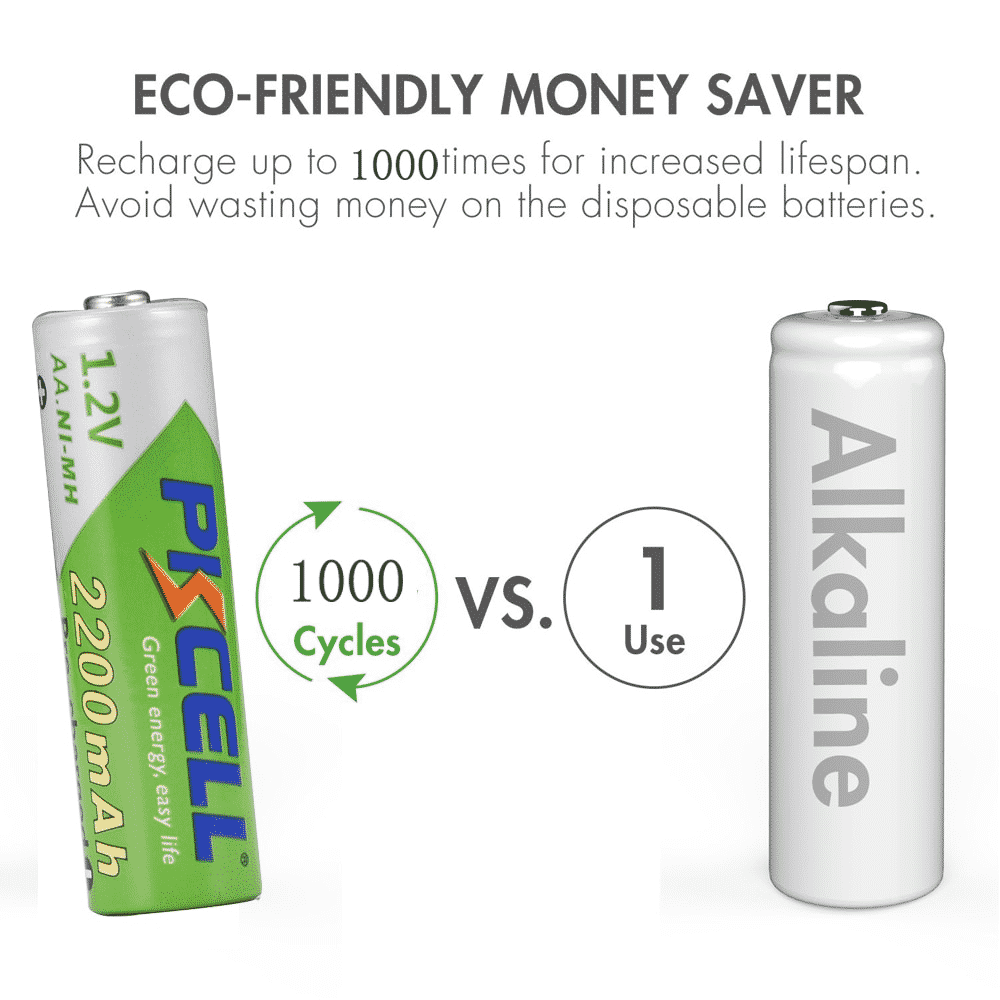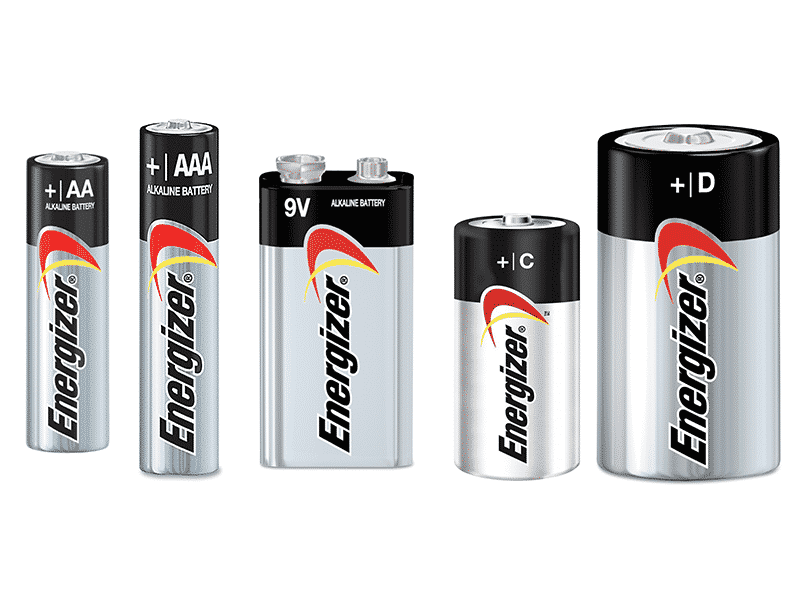The Top 10 Best Rechargeable Alkaline Batteries
“We’ve compared the best Alkaline batteries available at the most competitive prices.”

Best Alkaline Battery Reviews
The name ‘alkaline’ refers to the alkali metal hydroxide cores of these batteries. Alkaline batteries are often referred to as zinc-based batteries because they use an alkaline electrolyte and a cathode made from zinc. In 2020, Alkaline batteries are popularly used in toys, flashlights, and portable radios. They are also used in smoke detectors. It is common for real fire alarms to use lithium batteries, but fake alarm models that people install in their homes are often powered by alkaline cells.
Alkaline batteries are usually more expensive than other kinds of primary batteries, and they have a lower energy capacity. Because of this, most people prefer to use primary lithium cells. Alkaline batteries are used as a power source. They supply electric current for various devices, like calculators and remote controls. Why are alkaline batteries produced? The primary reason for making batteries is to create a ready source of stored energy.
In this case, the purpose is to supply power for devices like remote controls. What are the properties of batteries? Batteries store energy chemically. They do this by keeping chemical potential energy in molecules. Batteries are manufactured to have a very high chemical potential energy density. This means that they can store a lot of power in as compact an area as possible.
- Rechargeable: Yes
- Voltage: 1.2V
- Capacity: 3000mAh
- Recharge Cycles: 1000
- Size: AA
- Rechargeable: Yes
- Voltage: 1.2V
- Capacity: 3000mAh
- Recharge Cycles: 1000
- Size: AA
- Rechargeable: Yes
- Voltage: 1.2V
- Capacity: 3300mAh
- Recharge Cycles: 1000
- Size: AA
- Rechargeable: Yes
- Voltage: 1.2V
- Capacity: 3000mAh
- Recharge Cycles: 1000
- Size: AA
- Rechargeable: Yes
- Voltage: 1.2V
- Capacity: 2200mAh
- Recharge Cycles: 1000
- Size: AA

How Do The Best Rechargeable Alkaline Batteries Work?
Alkaline batteries are the most common type of battery, and they contain a metallic anode and a non-metallic cathode. These kinds of batteries produce electrons to neutralize ions that build upon their electrodes during use.
Alkaline batteries are called ‘alkaline’ because they have a chemical makeup that is alkaline, rather than acidic. The anode and cathode of an alkaline battery both contain potassium hydroxide; this means the battery has a high pH level.
The cathode of a battery works by producing electrons, which are then pushed out of the battery. This process can be observed in action when a zinc-carbon or alkaline cell is connected to an electrical circuit, and it starts emitting bubbles.
This means that the electrode has been eroded. The anode of a battery works by neutralizing ions. This is done when electrons are given up to the ions, which results in them giving up their surplus energy and becoming less active.
The Rechargeable Batteries Designed With Alkaline are Engineered Differently.
Alkaline batteries are an excellent example of a supply chain mechanism. They rely on many companies working together to provide the best service possible, and it is significant for all these parts that they work well with each other. Each factor contributes to the overall efficiency of the battery. Firstly, the process of manufacturing batteries relies on several different companies working together.
The raw material is extracted from one supplier and transported to another for it to be used in the battery production process. This has to be done very efficiently. Otherwise, there will not be enough supply for the factories which produce the batteries. Also, the companies which produce batteries need to work well with one another. For example, if a company making the raw materials for batteries goes out of business or has problems delivering their products on time, then there will be an issue with production, and this will impact negatively on all orders.

How Long do Rechargeable Alkaline Batteries Last?
An excellent place to start is by understanding that there are two different kinds of alkaline batteries. There are zinc-carbon ones and the newer lithium models. Zinc-carbon batteries are the older, less efficient type.
They still allow devices to operate for a reasonable amount of time, but not as long as lithium ones. Lithium batteries are the newer type. They can be used on many different devices, including small flashlights and portable radios. Lithium batteries can last a lot longer than zinc-carbon ones.
They are also smaller and lighter, so they do not take up as much space in electrical devices. The life expectancy of a battery should correlate with how often it is used. The more often it is used, the sooner you will need to replace your old worn-out batteries.
Where Are Rechargeable Alkaline Batteries Mostly Made?
Alkaline batteries are made of a combination of metals and metal oxides. They can be produced using the electrolysis reaction to produce oxygen gas, which is then combined with other materials to create an oxide or a hydroxide, depending on the type of alkaline battery that is being made. It’s important to note that any alkaline battery has both positive and negative ions present within it at all times. For example, the most common type of alkaline battery is a zinc-carbon one.
In this battery, the carbon acts as anodes, while zinc acts as cathodes. These two metals are then mixed with manganese dioxide and a solution of potassium hydroxide or naphthalene to create the electrolyte, which allows for an electrical charge to be conducted around for it to work. There are also alkaline batteries that have manganese dioxide inside of them as well. As the battery is being used, this can be converted to hydroxide through a chemical reaction, which allows it to continue working.

How Much Do The Best and the Worst Rechargeable Alkaline Batteries Cost?
Alkaline Batteries are of good value. They are used in many applications, including digital watches and smoke detectors. I read on Wikipedia that alkaline batteries account for 23% of all battery sales worldwide.
The price of an alkaline battery may be high because it costs more to manufacture, or the salesperson that you are dealing with may have a low opinion of your intelligence and charge you accordingly.
Another factor is that some companies, such as Duracell, manufacture their batteries and sell them under another brand name. This allows the company to charge a premium price, in which case you are essentially paying for advertising. You should also check the price per battery, as some packages may be cheaper even if they cost more initially.
- Rechargeable: Yes
- Voltage: 1.2V
- Capacity: 3000mAh
- Recharge Cycles: 1000
- Size: AA
- Rechargeable: Yes
- Voltage: 1.2V
- Capacity: 3000mAh
- Recharge Cycles: 1000
- Size: AA
- Rechargeable: Yes
- Voltage: 1.2V
- Capacity: 3300mAh
- Recharge Cycles: 1000
- Size: AA
- Rechargeable: Yes
- Voltage: 1.2V
- Capacity: 3000mAh
- Recharge Cycles: 1000
- Size: AA
- Rechargeable: Yes
- Voltage: 1.2V
- Capacity: 2200mAh
- Recharge Cycles: 1000
- Size: AA
Read Rechargeable Alkaline Battery Reviews Before You Buy Them(to Avoid Problems!)
A battery is a storage device for electricity. It takes energy in the form of electric potential and converts it into usable energy, which can be used to power almost any electrical device or appliance. The exciting thing about a battery is, unlike many other methods of storing electricity, like large servers or power plants that generate it as needed. Batteries are used everywhere to keep the energy we need for our daily lives.
The battery is an ancient device invented by the Romans. Yet it has evolved quite a bit over the years. The primary mechanism of energy storage and conversion remains virtually unchanged, but new features have been added to make batteries safer and more effective. However, this primary mechanism is fundamentally flawed. The problem lies in the fact that while a battery takes energy and converts it into electricity, but to do so, some of its stored energy must be transformed into heat. This process creates many problems. Heat is a form of life, but one that cannot be used to power anything. It just dissipates and gets more intense the hotter it gets.